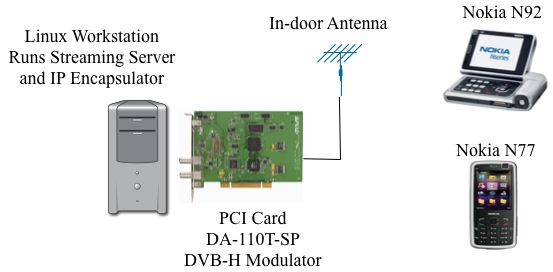Difference between revisions of "Hardware/Computing Resources in NSL"
| Line 7: | Line 7: | ||
== Mobile TV Testbed == | == Mobile TV Testbed == | ||
| − | + | This testbed is used to evaluate several of our algorithms that aim to improve mobile TV quality and usability. We configure a commodity Linux workstation as our streaming server as well as IP encapsulator that converts a video over IP stream into a MPEG-2 traffic stream. This Linux workstation also hosts a PCI-based DVB-H modulator card that is connected to an in-door antenna. We currently use a few Nokia mobile phones as TV receivers, which enables us to gather several performance metrics such as video quality, CPU loads, and energy consumption (battery-life). In particular, this testbed consists of: | |
| + | * An Intel Quad-Core Xeon E5420 (2.5 GHz) PC running Ubuntu Linux. | ||
| + | * A Dekted DTA-110T DVB-T/H Modulator and UHF Upconverter for PCI Bus. | ||
| + | * A Nokia N-92 mobile TV phone. | ||
| + | * Open source IP encapsulator software from http://amuse.ftw.at/downloads/encapsulator . | ||
| + | |||
| + | [[Image:MobileTV.jpg]] | ||
Revision as of 11:15, 20 May 2008
The Network Systems Lab is well-equipped to conduct networking and multimedia research. The figure below depicts some of the computing resources available in the Network Systems Lab.
Mobile TV Testbed
This testbed is used to evaluate several of our algorithms that aim to improve mobile TV quality and usability. We configure a commodity Linux workstation as our streaming server as well as IP encapsulator that converts a video over IP stream into a MPEG-2 traffic stream. This Linux workstation also hosts a PCI-based DVB-H modulator card that is connected to an in-door antenna. We currently use a few Nokia mobile phones as TV receivers, which enables us to gather several performance metrics such as video quality, CPU loads, and energy consumption (battery-life). In particular, this testbed consists of:
- An Intel Quad-Core Xeon E5420 (2.5 GHz) PC running Ubuntu Linux.
- A Dekted DTA-110T DVB-T/H Modulator and UHF Upconverter for PCI Bus.
- A Nokia N-92 mobile TV phone.
- Open source IP encapsulator software from http://amuse.ftw.at/downloads/encapsulator .
Wireless Sensor Testbed
The testbed is used to implement and test our coverage and connectivity protocols for wireless sensor networks. It contains:
- 10 sensors model xxx
- software
Access to PlanetLab WAN Testbed
PlanetLab is composed of several hundred machines distributed all over the Internet. We are a member of this testbed. We use this testbed to test the systems that we develop in realistic environments. For example, our pCDN system was tested with thousands of clients distributed over a few hundreds PlanetLab nodes.
Servers and Cluster
There are several decent servers in our Lab, as well as a cluster of machines for conducting large-scale experiments and simulations.
- nsl: Lab web and file server. Has more than 2 TB of (RAID) storage. It has 8 cores (4 cores per processor), 8 GB memory.
- nsl-cpu: Fast compute server to run simulations and large-scale experiments. It has 8 cores It has 8 cores (4 cores per processor), 8 GB memory.
- nsl-win: Windows Terminal Server for remote access. It has most of the needed Microsoft software.
- nsl-cluster: A number of machines (currently 12) interconnected through a gigbit Ethernet switch. They can be configured in different topologies to test our code. They could form an isolated network for experimentation. They also can be used for general processing such as running multiple replicas of a simulation code.
- Workstations: For use by students.
Miscellaneous Items
- Wireless Interface Cards (3): Model xxx , they have open-source Linux driver. We use them to build a WLAN testbed to test power-aware video streaming in wireless networks.
- Routers and NAT boxes (5): Different types/models: xxx, xxx We use them to test our NAT traversal schemes being developed for the pCDN system.
- 'Graphics Processor Units (GPUs):' xxx
- HDTV cards: xxx
These computing resources are partially funded by an NSERC RTI Grant.

